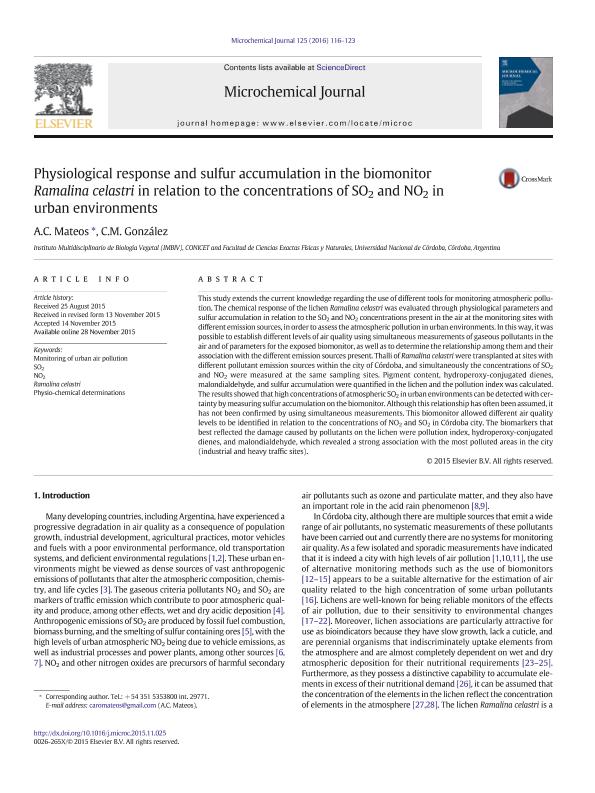Mostrar el registro sencillo del ítem
dc.contributor.author
Mateos, Ana Carolina

dc.contributor.author
Gonzalez, Claudia M.

dc.date.available
2017-06-06T21:52:44Z
dc.date.issued
2016-03
dc.identifier.citation
Mateos, Ana Carolina; Gonzalez, Claudia M.; Physiological response and sulphur accumulation in the biomonitor Ramalina celastri in relation to the concentrations of SO2 and NO2 in urban environments; Elsevier Science; Microchemical Journal; 125; 3-2016; 116-123
dc.identifier.issn
0026-265X
dc.identifier.uri
http://hdl.handle.net/11336/17653
dc.description.abstract
This study extends the current knowledge regarding the use of different tools for monitoring atmospheric pollution. The chemical response of the lichen Ramalina celastri was evaluated through physiological parameters and sulphur accumulation in relation to the SO2 and NO2 concentrations present in the air at the monitoring sites with different emission sources, in order to assess the atmospheric pollution in urban environments. In this way, it was possible to establish different levels of air quality using simultaneous measurements of gaseous pollutants in the air and of parameters for the exposed biomonitor, as well as to determine the relationship among them and their association with the different emission sources present. Thalli of Ramalina celastri were transplanted at sites with different pollutant emission sources within the city of Córdoba, and simultaneously the concentrations of SO2 and NO2 were measured at the same sampling sites. Pigment content, hydroperoxy conjugated dienes, malondialdehyde and sulphur accumulation were quantified in the lichen and the pollution index was calculated. The results showed that high concentrations of atmospheric SO2 in urban environments can be detected with certainty by measuring sulphur accumulation on the biomonitor. Although this relationship has often been assumed, it has not been confirmed by using simultaneous measurements. This biomonitor allowed different air quality levels to be identified in relation to the concentrations of NO2 and SO2 in Córdoba city. The biomarkers that best reflected the damage caused by pollutants on the lichen were pollution index, hydroperoxy conjugated dienes and malondialdehyde, which revealed a strong association with the most polluted areas in the city (industrial and heavy traffic sites).
dc.format
application/pdf
dc.language.iso
eng
dc.publisher
Elsevier Science

dc.rights
info:eu-repo/semantics/openAccess
dc.rights.uri
https://creativecommons.org/licenses/by-nc-nd/2.5/ar/
dc.subject
Monitoring of Urban Air Pollution
dc.subject
So2
dc.subject
No2
dc.subject
Ramalina Celastri
dc.subject
Physio-Chemical Determinations
dc.subject.classification
Ciencias Medioambientales

dc.subject.classification
Ciencias de la Tierra y relacionadas con el Medio Ambiente

dc.subject.classification
CIENCIAS NATURALES Y EXACTAS

dc.title
Physiological response and sulphur accumulation in the biomonitor Ramalina celastri in relation to the concentrations of SO2 and NO2 in urban environments
dc.type
info:eu-repo/semantics/article
dc.type
info:ar-repo/semantics/artículo
dc.type
info:eu-repo/semantics/publishedVersion
dc.date.updated
2017-06-06T14:42:51Z
dc.journal.volume
125
dc.journal.pagination
116-123
dc.journal.pais
Países Bajos

dc.journal.ciudad
Amsterdam
dc.description.fil
Fil: Mateos, Ana Carolina. Consejo Nacional de Investigaciones Científicas y Técnicas. Centro Científico Tecnológico Conicet - Córdoba. Instituto Multidisciplinario de Biología Vegetal. Universidad Nacional de Córdoba. Facultad de Ciencias Exactas Físicas y Naturales. Instituto Multidisciplinario de Biología Vegetal; Argentina
dc.description.fil
Fil: Gonzalez, Claudia M.. Consejo Nacional de Investigaciones Científicas y Técnicas. Centro Científico Tecnológico Conicet - Córdoba. Instituto Multidisciplinario de Biología Vegetal. Universidad Nacional de Córdoba. Facultad de Ciencias Exactas Físicas y Naturales. Instituto Multidisciplinario de Biología Vegetal; Argentina
dc.journal.title
Microchemical Journal

dc.relation.alternativeid
info:eu-repo/semantics/altIdentifier/url/http://www.sciencedirect.com/science/article/pii/S0026265X15002957
dc.relation.alternativeid
info:eu-repo/semantics/altIdentifier/doi/http://dx.doi.org/10.1016/j.microc.2015.11.025
Archivos asociados
